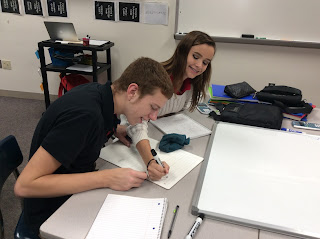The students have practiced writing linear equations given slope and a point, today we start learning how to write equations given two ordered pairs. They do have enough information/knowledge to do this without instruction. Let's see how it goes.
Introduction:
Review the problems we did yesterday (given slope and point). Discuss the two pieces of an equation in slope-intercept form (slope and y-intercept), discuss what those two things look like on a graph. Emphasize that in order to write an equation in slope-intercept form, you have to have the slope and y-intercept. If it's not given to you, go find it!!
Group Work:
Give each group a large white board and remind them that they have access to any supplies on the supply table (rulers, graph paper, etc). Student may also use desmos, but it will have to be their idea, I won't suggest it.
Write this on the board, "Determine the equation of the line that passes through the points (6, 7) and (10, 9)." The answer is y = 1/2x + 4
Each group is to write on their boards how they figured out the equation. We will share with the rest of the class. I'm hoping for different methods. If they don't have different methods, I will have to show them myself I suppose.
Any group that finishes early will get a more challenging problem. "Write the equation of the line that passes through the points (-3, -1) and (6, 5)." Answer: y = 2/3x + 1
Exit Ticket:
A) Write the equation of the line that has a slope of 3 and passes through the point (4, 2).
B) Write the equation of the line that passes through the points (4, 5) and (6, 8).
What Really Happened:
Many students were still confused when given slope and a point, so I spent more time on that than I would have liked. We ran out of time for the exit ticket.
Introduction:
Review the problems we did yesterday (given slope and point). Discuss the two pieces of an equation in slope-intercept form (slope and y-intercept), discuss what those two things look like on a graph. Emphasize that in order to write an equation in slope-intercept form, you have to have the slope and y-intercept. If it's not given to you, go find it!!
Group Work:
Give each group a large white board and remind them that they have access to any supplies on the supply table (rulers, graph paper, etc). Student may also use desmos, but it will have to be their idea, I won't suggest it.
Write this on the board, "Determine the equation of the line that passes through the points (6, 7) and (10, 9)." The answer is y = 1/2x + 4
Each group is to write on their boards how they figured out the equation. We will share with the rest of the class. I'm hoping for different methods. If they don't have different methods, I will have to show them myself I suppose.
Any group that finishes early will get a more challenging problem. "Write the equation of the line that passes through the points (-3, -1) and (6, 5)." Answer: y = 2/3x + 1
Exit Ticket:
A) Write the equation of the line that has a slope of 3 and passes through the point (4, 2).
B) Write the equation of the line that passes through the points (4, 5) and (6, 8).
What Really Happened:
Many students were still confused when given slope and a point, so I spent more time on that than I would have liked. We ran out of time for the exit ticket.
This group understood/remembered how to find the slope algebraically using the slope formula. Unfortunately, they use the formula incorrectly. They were considering using the point-slope formula but were afraid of being wrong, so they did nothing at that point.
This group decided to use graph paper and determine the slope and y-intercept graphically. All groups forgot that reducing was an option. This particular group couldn't "find" the y-intercept because they didn't graph a point there. I encouraged them to get a ruler just to see what would happen.
This group correctly found the slope algebraically. They wanted to try guess and check, but couldn't figure out the "check" part.
This group found the slope graphically, then found the y-intercept algebraically. Interesting.
Students hard at work.
Students notice I have a camera.
One group double-checked their work by substituting both points into the equation.
This group never gave up. They argued, they bickered, they struggled, but they never gave up. I'm so proud.
Solved by graphing in about 2 minutes. Fantastic!!
Solved algebraically.
I wanted to challenge this group to not use a graph by giving the ordered pairs (24, 6) and (-3, -3). They surprised me by getting another graph out. haha. Jokes on me.
Another algebraic.
This blew me away. I was so impressed with this group and their use of slope and understanding.
The group that only graphed, I finally challenged to find another method. They did it!!
Another group that graphed.
This group did the (24, 6) (-3, -3) problem by graphing. They used a scaled graph. How stinkin' awesome is that!?!?!






















Comments
Post a Comment